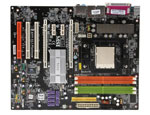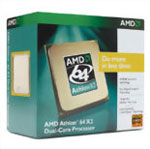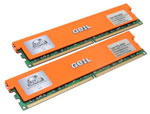Baseline AMD High-End Platform
Starting with the AMD basic high-end offering, it should come as little surprise that you still get a powerhouse of a computer for the cost. A fast processor, dual graphics cards, 2 GB of RAM, and a good amount of hard drive space will keep all but the most demanding users satisfied. We won't be putting together an equivalent Intel system, as we already mentioned, but it could certainly be done. Let's take a closer look at a few of our component choices, and discuss some of the alternatives you might want to consider.
 |
The choice of motherboard determines in a large part what sort of system you are going to build. A high-end gaming system will come with dual X16 PCI-E slots, often with full X16 bandwidth to each slot. The truth of the matter is that PCI Express graphics cards are rarely starved for bandwidth, so dropping down to X8 bandwidth won't have a dramatic impact on performance. We saved about $40 by going with the MSI K9N-SLI Platinum motherboard, which uses the nForce 570 SLI chipset as opposed to the nForce 590 SLI chipset. The motherboard won't overclock quite as far as some other offerings, and during our testing for the review we found that it seemed to hit a brick wall very quickly once you passed a certain point. If you can live with the approximately 315 MHz top bus speed "limitation", however, the board still performs admirably.
 |
Moving on to the processor, we have chosen what is best classified as a moderately fast AMD offering, the Athlon X2 4600+. When the AM2 processors first launched, the 4600+ carried a price tag of nearly $600. We didn't really recommend the processor then, but with the updated price of roughly $250 it becomes a lot more attractive. We considered recommending an upgrade to the 5000+, with a price of roughly $365, but at present many places that stock the CPU at that price are backordered. Besides, as we've already stated, Intel definitely has the performance advantage anyway, so if you're looking at getting a reasonably high-end AMD system you might as well save a bit of money. Overclocking is always an option, and we have found that most dual core AMD AM2 processors top out somewhere between 2.6 and 2.8 GHz without resorting to extreme cooling, in which case you would again be better off saving the money and getting a slightly slower stock clock speed.
 |
The choice of memory sparked some serious debate here at AnandTech, as well as a vigorous search of many vendors along with our own pricing engine in an attempt to find the best performing memory at the lowest cost possible. We mentioned this in our last midrange guide, and we will reiterate the point here:
DDR2 memory prices have skyrocketed over the past couple of months. You could find 2 GB of reasonably performing DDR2 memory for only $150 two months ago, but now the cheapest price you will find for such memory is $200, with the better performing options costing over $250. Given that our baseline AMD configuration is more of a "budget high-end" system, we tried to keep the costs down as much as possible. We still wanted to get some DDR2-800 memory with CL4 timings, however, as memory with those specifications generally marks the beginning of the high-end RAM. Our own memory reviewer relayed the following information, which is worth repeating: "Corsair, Crucial, Kingston, G.Skill, GeIL, Mushkin, OCZ, Patriot, Super Talent, and TEAM (and several others as well) have all been very competitive at the same speed grade in DDR2." Basically, if you buy memory with the same specifications, the difference from one manufacturer to another is not going to be huge. With this in mind, we looked for DDR2-800 memory with good timings and tried to find the lowest current price. As you can see, we ended up with a GeIL Ultra 2x1GB kit. If prices change in the near future and one of the other manufacturers offers DDR2-800 CL4 RAM at a better price, they would get our pick for "budget high-end" memory.
 |
Having selected an SLI motherboard, we of course chose to go with two NVIDIA graphics cards. There are many options currently available, but generally speaking we feel you should get the fastest single card you can purchase up until the GX2 before moving to dual graphics cards. In other words, we would take a single fast 7900 series card over two 7600 GT cards. Once you reach the cost of the GX2 (about $500), many new options open up. Two 7900 GT cards would have been a good choice a month or two back, but these cards have now been displaced with the launch of the 7950 GT and the 7900 GTO. The 7900 GTO is basically a 7900 GTX design, including the large, quiet heatsink/fan, only with lower memory and core clock speeds. Many people have had good results in overclocking the GTO to GTX clock speeds, but even at the stock speeds it will be a very fast card. The only drawback is that the cards are dual slot designs, and the GTO cards don't currently include HDCP support. Relative to the 7900 GT, you will definitely get better performance, as you get twice as much memory with a faster core clock speed.
A near tie in terms of getting our recommendation is the 7950 GT cards. These have a slower clock speed than the GTO but include faster memory, they take up a single slot, and you can get HDCP support. They also cost a bit more than the GTO and they make more noise. We decided to save money and sacrifice expansion slots, and with many games starting to stress GPU core performance rather than memory bandwidth we feel the GTO will be faster. It ends up being a decision between features and price, however, so you should choose whichever appeals to you more.
Rounding out our component selections, we chose to go with a single 320GB hard drive and the obligatory 16X DVD burner. In both cases, we had an eye towards performance as well as price. For 320GB hard drives with 16MB of cache, the Seagate 7200.10 is currently the lowest price and offers compelling performance. You could always go with a smaller or larger hard drive, although the difference in price between 250GB and 320GB isn't very large. With Blu-Ray and HD-DVD on the horizon, DVD burners are all becoming very similar in specifications and performance. Media compatibility will still vary, but if you get the drive manufacturer's recommended brand you shouldn't have any problems, at which point you can simply choose whichever is cheapest. Once again, that honor falls to the NEC ND-3550A, with LG Electronics, BenQ, LiteOn, Pioneer, and others following close behind. The only thing to remember is to get an optical drive with a faceplate that will match your choice of case.
We will wrap up with a brief note on the operating system selection. All of the systems we are putting together today should be fully compatible with Windows Vista once it becomes available, not to mention Windows XP, Linux, and many other operating systems. You should also be able to run either 32-bit or 64-bit versions of any of these operating systems, although the overall performance and compatibility of Windows x64 OSes at present is lower than their 32-bit offerings. You then need to decide which specific package to get within the OS family, and for Windows XP that means choosing between Home, Professional, and Media Center Edition. For anyone that runs more than a single computer on a network, we definitely don't recommend XP Home. Media Center Edition and XP Professional use the same code base, with a few minor differences. We feel MCE is the most versatile choice overall, and the fact that it is $20 cheaper helps to seal the deal. If you plan on running 4GB of memory or more, you will probably want to upgrade to a 64-bit OS, but we will continue to recommend 32-bit Windows and 2GB of RAM for the time being.














45 Comments
View All Comments
JarredWalton - Monday, October 9, 2006 - link
Try configuring a similarly equipped "ultra" system at any of the vendors you mentioned for $5500 - including a 30" LCD, remember, plus speakers and all the other stuff. Note that all prices include shipping to the continental US (although tax is not included). Sure, you get support from one location, but we're not here to constantly recommend system vendors.There's a huge DIY audience that reads AnandTech, and at least this gives people a baseline price list that they can look at when they're considering pre-built systems. We try to cater to all markets, not just the vendors that buy advertising.
Powersupply - Monday, October 9, 2006 - link
As always someone has to be the annoying person who feels this or that is missing. Today it is me.1. I can't see why Thermalright Ultra-120 should be missing from the selection of CPU coolers. It performs on par or better than the Infinity with the same fan.
2. Why not putting more than 2 harddrives into the "Ultra High-End Platform"? After all you went with a stacker case who got plenty of space. 2 x Raptor + 2 x Other HDD would be sweet.
JarredWalton - Monday, October 9, 2006 - link
Added mention of the Thermalright. As for the HDDs, I quote from the original text:I believe that fully covers your second comment, right? It's always an option, but it's not required by any means.
yacoub - Monday, October 9, 2006 - link
The Antec P150 is such a superb case I can't believe it does not many any of your four case recommendations. It is an ideal case in that it is built for quietness, airflow, ease of cleaning, and ease of access. Everything about it is pretty much perfect AND it's not upside-down like the more "popular" Antec P180 case, nor does it have a silly topvent. It's also a little more reasonably-sized (I don't know of anyone building a gaming PC that needs more than 2-3 5.25" bay drives nor room for more than 3-4 hard drives. Really, this case has it all. It's probably the one part of my current build I'm most satisfied with and have been since purchase, which was when they first came out about a year ago.JarredWalton - Monday, October 9, 2006 - link
Some people love the P180, others love the P150, and still others think the ASUS plastic monstrosity is the coolest looking case ever. I figured with a choice of the SLK-3000 and P180, I needed someone other than Antec to represent the case section. :)